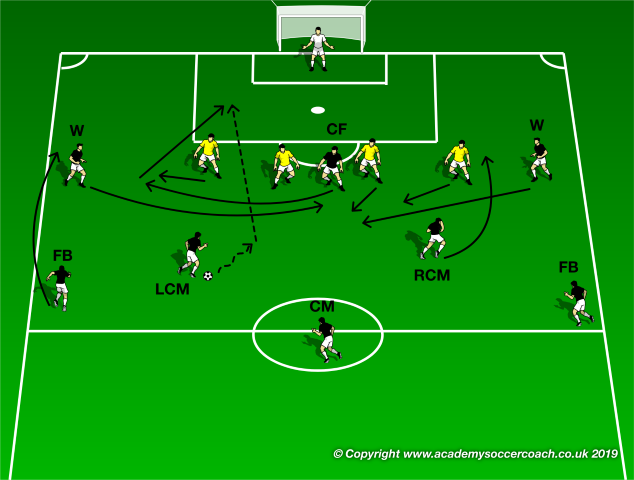WORLD CLASS COACHING
4-3-3 Attacking
By Luca Bertolini
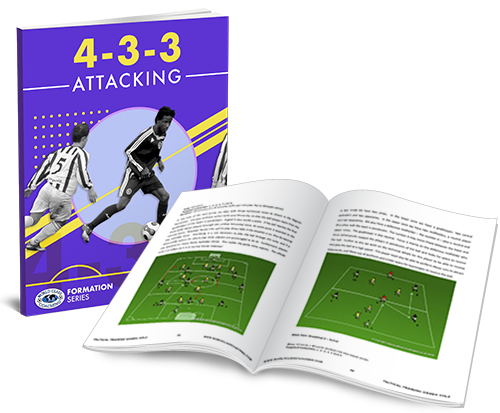
Table of Contents
PART TWO
Possession and Key Attacking Principles
Movement Without the Ball - Variation of Runs
Possession and Key Attacking Principles
Building up from the back and playing out: when the goalkeeper starts the possession phases (building up from the back) and when the ball is recovered (the transition phase should happen as quickly as possible to counter attack, if possible, or to shape the team, in order to give the best possible options for the new ball carrier), width should be created using the fullbacks and/or wingers (but with center backs also inside the first third). Depth should be provided by the goalkeeper, center backs, center mid¬fielders and center forward (center backs should be able to to break down an opposition pressure line in the first third; the center forward should be able to overcome another pressure line in the middle third, to play all around the final third.)
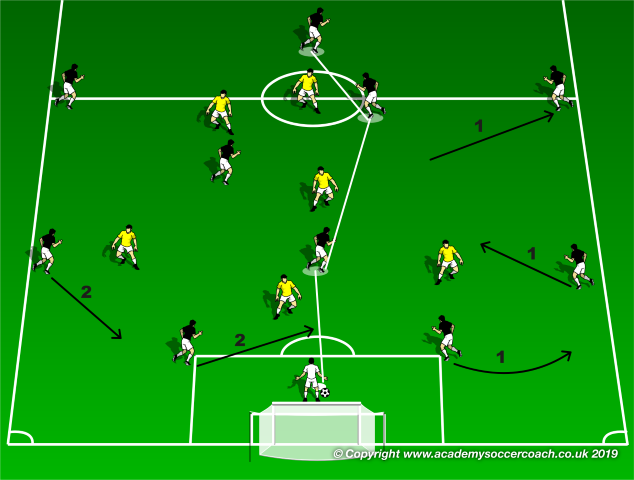
The first goal should be to play forward to overcome the lines of the opposition, when the closure of passing lanes is the main defending strategy, but when this is not possible, the build-up or play out phases should be useful to maintain the possession, to buy time, move the opponents and find exploitable spaces; in this second situation, positional play around the ball is very important to ensure possession of the ball for the team and to manage the opposition pressure.
This allows the team to control the game, creating gaps within the opposition shape to exploit and put less pressure on the team. The mobility of players, creating the correct options, space, angles and balance with high tempo especially within the midfield three is the key to lead the first phase of possession to successful and effective actions.
Creativity: to try to break down defenses by employing the element of surprise. Skills such as back-heels, cut backs, flicks, feints and fakes are all used to this end. Comfort on the ball is critical and this training starts in the 1st stage of development. When playing in a 1-4-3-3 system, the centre backs and the defensive midfielder give a solid de¬fensive base, allowing freedom for the attacking midfielders and the three forwards to be creative, trying to break down the opposition, penetrate and create goal scoring opportunities.
Positive possession-based play:
Diagonal Passing: when players’ positioning, body shape and movements are correct, diagonal passing options come naturally, ensuring safety behind the ball if possession is lost and more available options for the new ball carrier, as he has the option to pass forward or back.
A possible combination can be performed by the defensive midfielder who can pass to either of the centre midfielders and then up to the centre forward. When the defensive midfielder plays the pass, he immediately moves to create a new option for the teammates to pass back, when under pressure.
Diagonal passes and overlap combinations: the first possible diagonal pass can be played from the fullback to the winger. Once the pass is played the winger must dribble inside, inviting the opposition fullback inside and creating space for the fullback of his team to run into. The winger can then pass into the space along the fullbacks' paths or play toward the center forward, who can then perform the final diagonal pass into the space for the fullback to run onto from deep.
Vertical Passing: they are used during attack¬ing phases to penetrate opposition lines, as they can pull a lot of opponents out of their defensive positions, bypass¬ing the entire defense or midfield with one pass. For example, after combinations in central areas, vertical passes can be made into the space for the wingers making diagonal runs.
Creating the correct options: to cre¬ate the correct options, making angles with depth and correct distance in between to create triangle and rhombus shapes that can be exploited with vertical and diagonal passes are necessary for the development of the attacking phase.
1) If fullbacks use the maximum width and the centre backs and the defensive midfielder provide depth between them to create the first triangles, offering various different options.
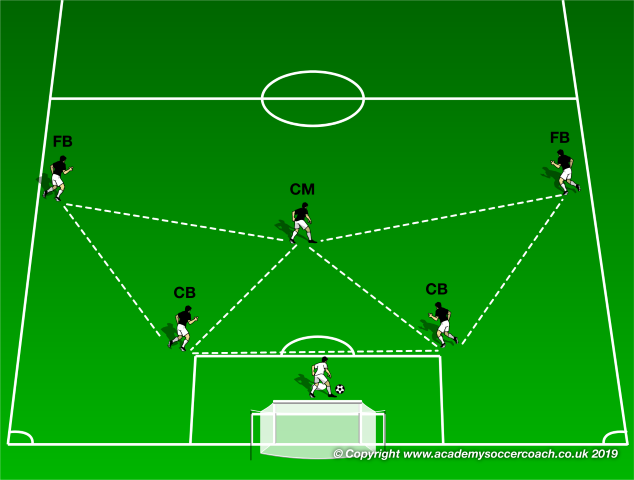
2) If fullbacks run inside to provide depth in the middle third, the centre backs move wide and the defensive midfielder provide depth at the back, between them, to create the first triangles, offering other kinds of options.
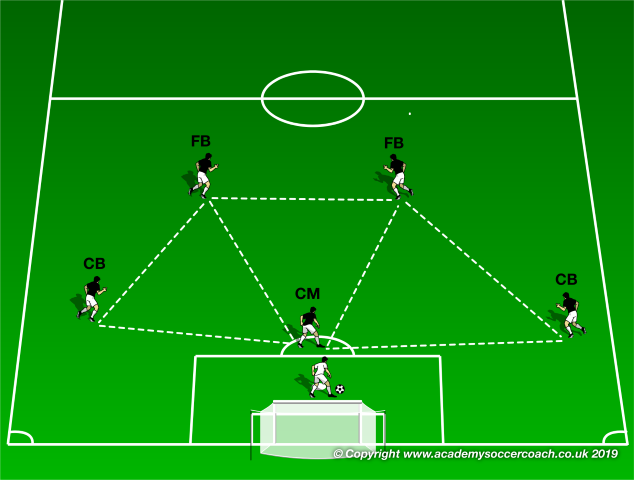
3) The defensive midfielder at the base of the triangle provides depth, balance and an option to play back to, if the forward pass is not available. The right and left centre midfielders give an option either side not being on a straight line.
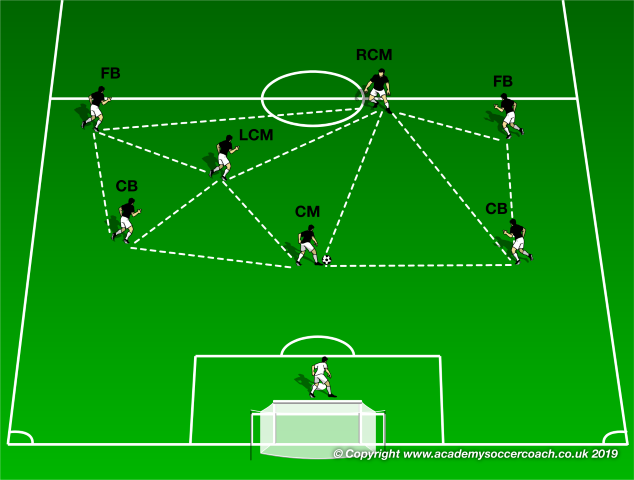
4) If the center midfielder is an advanced player, the other 2 must provide depth and balance (the lower one) and a side option, being placed wider in relation with the position of the upper one.
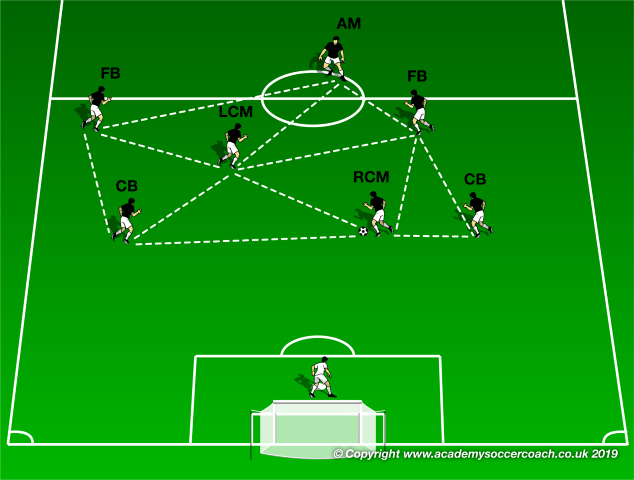
5) The defensive midfielder together with the right or left centre midfielder and the centre forward create other options of a triangular shape creation op¬tions.
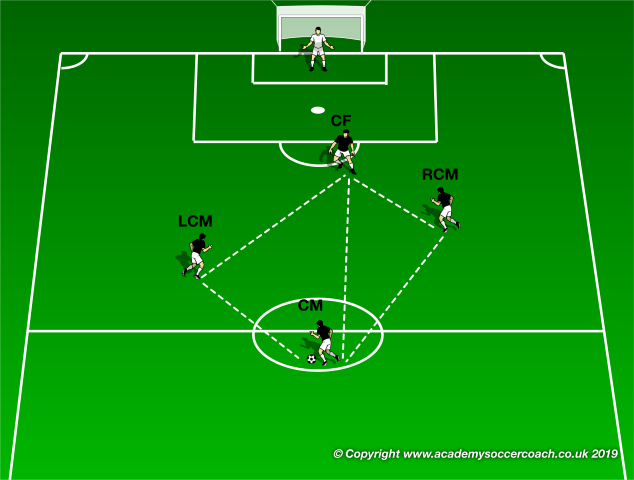
6) A rhombus can be created using one of the fullbacks, the centre midfielder, a winger and the centre forward.
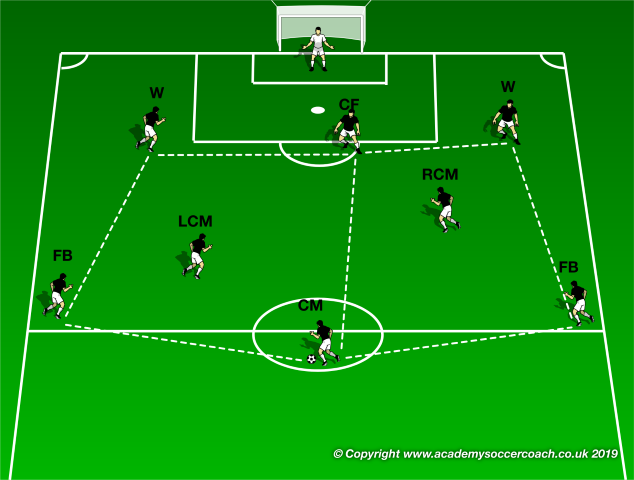
7) Another alternative rhombus option is shaped through the center of the field with midfield 3 and the center forward.
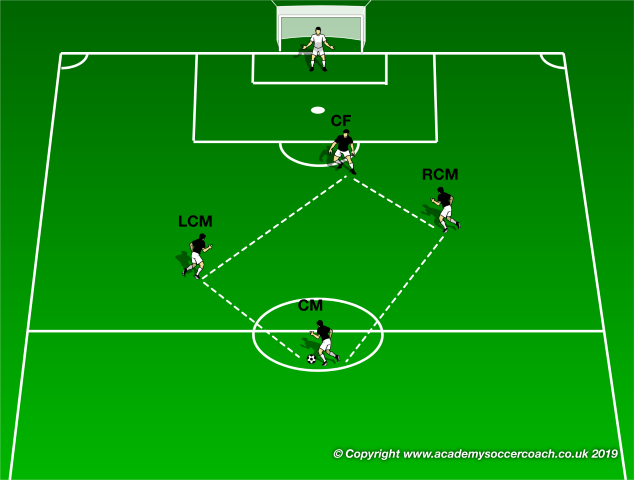
Movement Without the Ball - Variations of Runs
1) Runs in behind the opposition back four: when the midfielders or fullbacks are in possession, the centre for¬ward or the wingers can make penetrating runs in behind either to re¬ceive the pass or to create space for others to exploit. They will first drop in short before spinning off and making the run in behind. The timing of run and pass is important to remain onside and to create an initial distance from the defender.
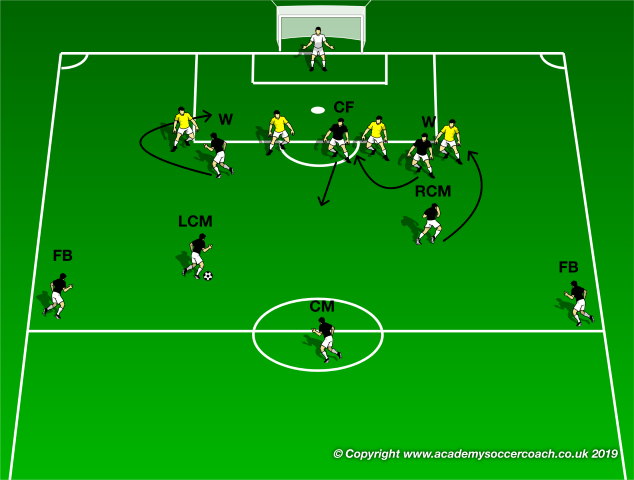
In the first example on the left the centre forward can receive the through ball in behind the centre back.
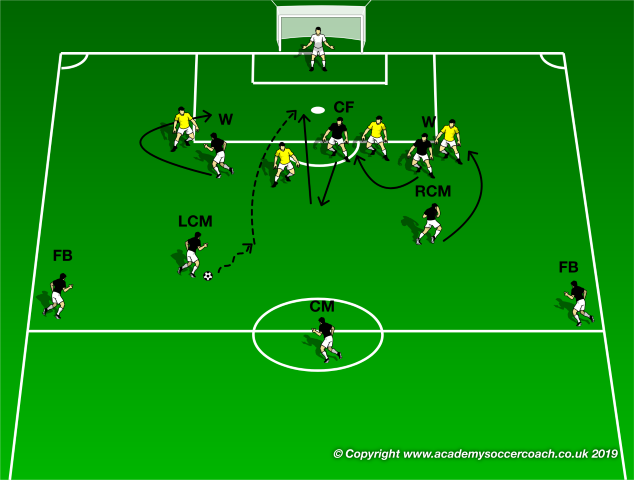
In the second example, the centre backs closely marks the centre forward but space is now created for the winger to run inside.
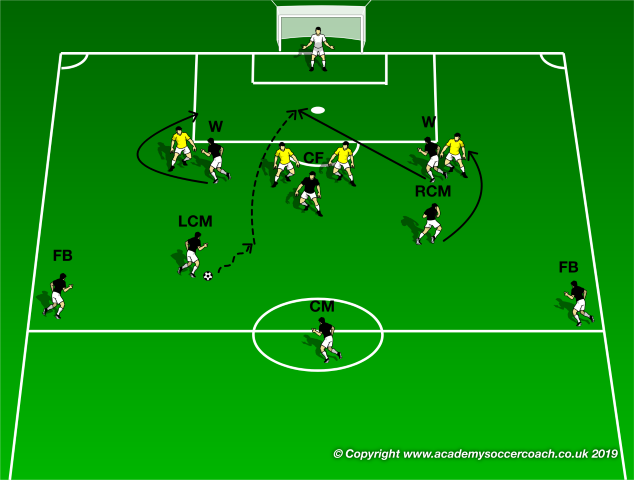
2) Diagonal runs: the wingers can also penetrate behind the defense by making diagonal runs, when they provided width during build up and possession phases. As one mid¬fielder receives the centre forward makes a movement in the opposite direction to invite the centre back away and this allows the winger to make the run inside and behind the fullback.
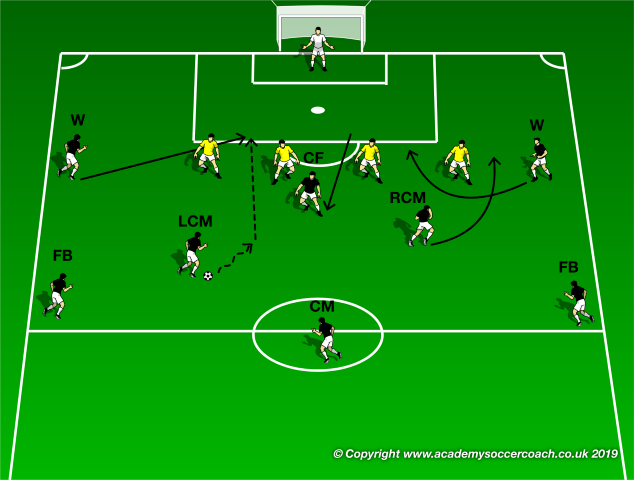
3) Channel Runs and interchange: the center forward can also make a run into the chan¬nel and interchange with one of the wingers, forcing the defenders to make decisions if to remain or to track the opponents. The ball carrier can then pass to one of the wingers or to the center forward if he has created space away from the opposition defender.
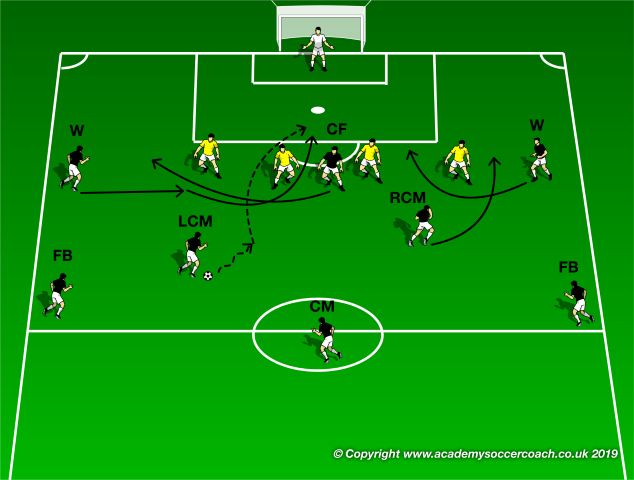
4) Interchanging and replacing options: being fluent in our movement as a team is much more effective in creating space to first lose markers and second, to make runs in straight lines with play frequently going sideward. In this first example, the wingers drop short and therefore the fullback or the wide midfielder can replace the wide positions and push higher up the field to give an option for the midfielders to play.
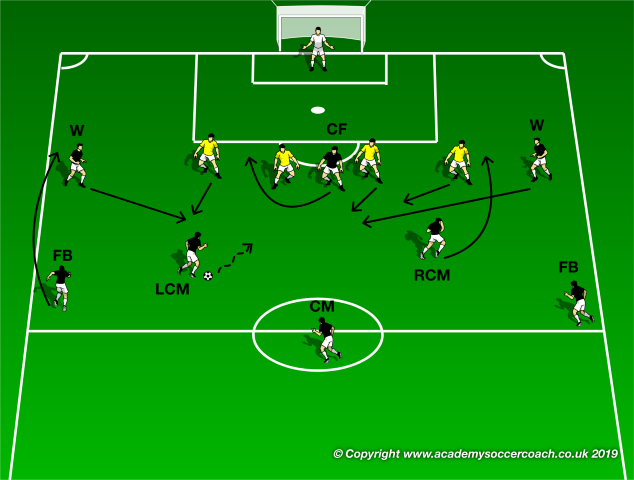
In the second example, the centre forward pulls wide to make a run into the channel. The winger then moves inside to become the centre forward and cre¬ate space for the centre forward to exploit.
